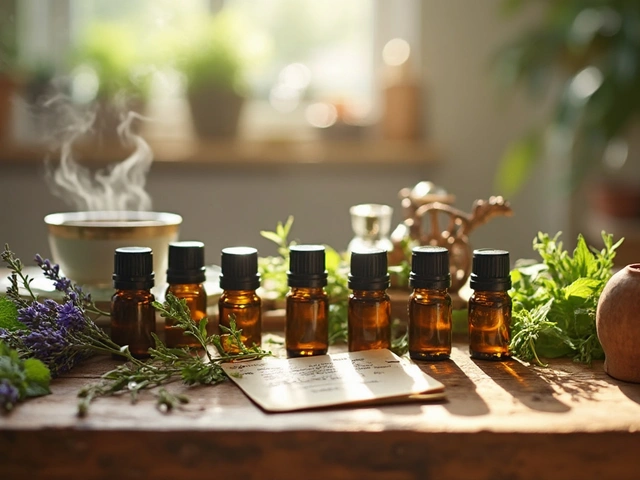In today's whirlwind world, stress hitches a ride with nearly everyone. It's the unwelcome companion that tags along, uninvited. But here's the silver lining: with just a few simple techniques, relaxation can be achieved at the drop of a hat.
Whether it's drawing a deep, calming breath or sinking into your favorite song, there are countless ways to whisk stress away. Through this article, you'll uncover methods that not only soothe the soul but empower you to face each day with renewed peace of mind.
- Mindful Breathing
- Progressive Muscle Relaxation
- Visualization Techniques
- Power of Music
- Nature as a Remedy
- Incorporating Relaxation into Daily Life
Mindful Breathing
Taking a moment to focus on your breath can sometimes feel like hitting the pause button on the chaos of life. This simple yet powerful technique, known as mindful breathing, is hailed as one of the most effective methods for stress relief. It's a practice rooted in ancient traditions and embraced universally for its ability to center the mind and promote calmness. Mindful breathing requires nothing more than conscious attention to the flow of breath in and out of the body. You don't need any special equipment or a tranquil setting, just a few minutes and your presence.
The beauty of mindful breathing is its flexibility and adaptability to any situation. Whether you're trapped in a cacophonous office or lost in thought while waiting for the bus, mindful breathing can instantly anchor you. To begin, find a comfortable position, either seated or lying down. Close your eyes if you wish, and take a deep breath in through your nose, slowly allowing your chest and abdomen to expand. Hold it for a moment, then release it gently through your mouth, feeling tension leave your body with your exhale. As thoughts intrude—and they will—acknowledge them and let them drift away like clouds across the sky, returning your focus to the rhythm of your breath.
Simple Techniques to Enhance Your Experience
Walking into the world of mindful breathing for the first time can feel like stepping into a still lake. It's important to dive in gently. A helpful technique is to count each breath cycle, a method often recommended to beginners. Start with a count of four for each inhale and each exhale. This count can be adjusted based on your comfort and lung capacity. Adding a slight pause between each inhalation and exhalation can also deepen the experience, promoting a greater sense of relaxation. Imagine each breath as a wave rolling in and out, steady and reliable. Practice regularly for a few minutes each day, and you'll likely notice a shift in your daily responsiveness to stress.
"Feelings come and go like clouds in a windy sky. Conscious breathing is my anchor." — Thich Nhat Hanh
Science backs up the benefits of mindful breathing. Research has shown that it can lower blood pressure, reduce anxiety levels, and even improve focus and emotional stability. A study conducted by Harvard in 2021 found that participants who practiced mindfulness meditation, which principally involves mindful breathing, exhibited increased levels of positive feelings and saw a significant decrease in stress markers. This free, natural, and accessible form of relaxation has rightfully earned its spot in mental wellness toolkits. By improving oxygen flow and calming the nervous system, it serves as a soothing balm for the mind. Mindful breathing is more than just a technique—it's an invitation to return to yourself, wherever you are.
Progressive Muscle Relaxation
Among the celebrated techniques in the realm of stress relief, Progressive Muscle Relaxation (PMR) shines as a beacon of simplicity and efficacy. It's a method that's all about teaching your muscles the art of relaxation, and you'd be amazed at how effective it can be. The technique was pioneered by an American physician, Edmund Jacobson, in the early 20th century. Jacobson believed that physical relaxation would significantly alleviate mental tension. And he was right! Today, modern science backs his theory, affirming that reducing bodily tension leads to a calm mind.
Start by finding a quiet spot where you won’t be interrupted. It can be a cozy corner at home, a peaceful nook in a park, or even a serene room at your workplace. The key is to ensure distractions are minimized. Sit comfortably, with your feet flat on the ground and your hands resting on your lap. Close your eyes gently and take a deep breath. Inhale through your nose, letting your chest rise and fall in a soothing rhythm. Now, you’re ready for the relaxation journey.
The essence of PMR is in actively tensing and then releasing specific muscle groups. Start with your toes. Curl them tightly and hold the tension for about five seconds. Feel the sensation of the stress in them, and then, very slowly, release the tension. Focus on the transition and the wave of relaxation that follows. Move upwards, to your calves, your thighs, abdomen, gradually across your body to your neck and face. Each muscle group gets its moment. The slow and deliberate release of tension is an invitation to calm.
What makes PMR particularly effective is its focus on contrast. It's like night and day; by experiencing the tension, your body appreciates the ensuing relaxation even more. Studies show that regularly practicing PMR can significantly lower blood pressure, improve focus, and even better manage chronic stress. Such findings make it a favorite among therapists and relaxation enthusiasts alike.
For those who are new to PMR, it's often helpful to have guided audio that can walk you through each step. Many resources are available online, ranging from short five-minute exercises to extensive half-hour sessions. As you become more familiar with the technique, you might find that you can conduct these sessions without guidance, using your own internal script. Frequency can vary, but even a short session once a day can do wonders for your mental wellbeing.
In a study published in the International Journal of Stress Management, researchers found that participants who practiced PMR regularly were more adept at handling stressful situations when compared to those who didn't. The practice seemingly instills a baseline of calm that's resilient even in turbulent times. The study highlighted that many individuals found solace in PMR, particularly in our modern-age hustle.

Visualization Techniques
When we talk about relaxation, one of the most powerful methods often gets overlooked: visualization techniques. It's a practice where the imagination plays a central role in calming the mind and reducing stress. At its core, visualization is about creating detailed and vivid images in your mind to take your focus away from stressors and transport you to a place of calmness and serenity. Many people find that these mental journeys affect their emotional state and physiological responses, leading to decreased anxiety and tension. Taking just a few minutes every day to practice visualization can have profound effects on both your mental health and your physical wellbeing.
You may wonder how something as simple as imagining can have such a profound effect. Visualization techniques often engage multiple senses, making them a full-bodied experience. By using all your senses, you not only see but also feel, hear, smell, and even taste the calming environment. This immersive experience has been known to trigger the relaxation response, which researchers describe as a state of deep rest that changes the physical and emotional responses to stress. This is why visualization is often employed by athletes and performers to reduce performance anxiety. By picturing success, they prepare their minds to handle pressure without breaking a sweat.
Getting started with visualization does not require much except some time and a quiet space. Begin by choosing a setting you find peaceful. This could be a pristine beach, a lush forest, or even a favorite childhood spot. Once the setting is selected, close your eyes and start to fill in the scene with sensory details. Imagine the warmth of the sun on your skin, the sound of leaves rustling, or the fragrance of blooming flowers. As you build this world, allow yourself to be fully immersed. It is in this immersion that you'll find stress beginning to melt away, replaced by calm.
Although visualization techniques are powerful, they involve more than just randomly conjuring up images. It is essential for your visualization to be vivid and detailed. Renowned psychologist, Dr. Kendra Cherry, suggests incorporating mindfulness into visualization, stating that "By focusing on sensory details in visualization, you can help your mind become more present and less scattered." Consider cataloging the sensations stone by stone, from the rough texture beneath your feet to the distant calls of birdlife overhead, anchoring your mind gently in the moment and easing away distractions.
In recent studies, it was found that visualization could remarkably reduce cortisol levels, the body's primary stress hormone, leading to boosted immune function and a decreased heart rate. This means it's not just a mental exercise; it has physical benefits that ripple through the body. Visualizing is often paired with mindful breathing or soft music to enhance the calming effects and offer a holistic approach to address mental fatigue and tension. Taking control of your mind’s eye turns out to be one of the most liberating forms of stress relief available.
Visualization techniques can also be tailored to suit your personal preferences. Some people find success with creating a serenity scene, where they walk along a tranquil path, while others may visualize a colorful tableau of energy to reenergize and motivate themselves. Experiment with different environments and find out what resonates and provides you with instant stress relief. Remember, the power lies in your mind, and with practice, you can wield this technique as a mighty tool against stress. Whether you employ it during a break, at the end of the day, or while waiting for a meeting to begin, its effects can be immediate and lasting.
Power of Music
Music has a magical allure that transcends boundaries and speaks directly to the heart. Each note, each rhythm, carries the power to transcend the ordinary and transport us into realms of peace and tranquility. That makes it an incredible tool for stress relief. Try immersing yourself in your favorite melody; it’s as if each chord effortlessly peels away layers of tension, peeling back the stress accumulated throughout the day.
Interestingly, science backs up this charming capability of music. Various studies reveal how music can significantly lower cortisol levels—the infamous stress hormone. One particular study published in the Journal of Music Therapy demonstrated that listening to music for just 30 minutes can reduce anxiety and stress significantly. Whether it’s classical tunes or the latest pop hit, simply pressing play can work wonders on our mood and mental state.
A beautiful aspect of music is its diversity. Whether you prefer the gentle sounds of an acoustic guitar, the precision of a piano, or the rhythmic pounding of drums, there’s something for everyone. Each genre carries its own soothing qualities. Classical music, with its structured grace, often helps individuals concentrate and calm their nerves. In contrast, upbeat pop tunes, bursting with energy, can invigorate and uplift one’s spirits. Finding the right fit for your needs can turn an average moment into something extraordinary.
Creating Personal Soundtracks
Just as a film relies on its soundtrack to amplify its emotional beat, creating a personal playlist can be your own tool for shaping emotions. Consider crafting a playlist tailored for different activities. Start with a morning playlist filled with invigorating songs that help you face the day with positivity. During work or study times, softer, more relaxing tunes can help perfect concentration and reduce stress. In the evening unwind with slow-tempo music to ease into a restful night.
It might surprise you to know how many top sports athletes utilize music as part of their preparation ritual. It acts as a motivator and a mental focus enhancer, proving music's versatility. Whether it’s rocking out before a match or calming nerves before a public speech, music finds its place comfortably in our various life scenarios.
Why not give it a try? The next time stress beckons, take a moment, close your eyes, and let your favorite tune be your guide to calmness. The beauty is, wherever you are, a little melody holds the potential to change how you feel, making music more than just a backdrop but a powerful ally in pursuit of calm.
"Music can change the world because it can change people." — Bono

Nature as a Remedy
Every now and then, stepping into the embrace of nature can feel like slipping away from life's constant demands. It's as if the great outdoors whispers secrets of calm and rejuvenation to those who take the time to truly listen. The simple act of being surrounded by greenery, the gentle sway of the trees, or the rhythmic lapping of water against rocks can be profoundly grounding. Spending time in natural settings, often referred to as 'forest bathing' or 'shinrin-yoku,' has roots in ancient practices from Japan. Studies have shown that being among trees can reduce cortisol levels, a key indicator of stress, leaving individuals feeling more relaxed and at peace.
The benefits extend beyond just stress relief. Nature's diverse offerings can also boost mental clarity and creativity. Consider a walk through a blooming meadow or a quiet moment by the riverbank. These experiences stimulate the senses, allowing your mind to wander freely and encouraging creative thoughts to bloom. For many, these moments of escape are not just about relieving stress; they are about finding inspiration and a renewed perspective. Albert Einstein once said,
"Look deep into nature, and then you will understand everything better."This statement rings true as the symbiotic connection between humans and nature unfolds with every leaf and stream.
Interestingly, it's not just the location but the sounds of nature that work wonders too. Researchers have discovered that natural sounds, like birdsong or the rustle of leaves, can significantly enhance our relaxation response. Adding recordings of such sounds to your daily routine can have similar benefits, especially when a trip outside is not feasible. A short pause to listen to these soothing sounds acts as a brief interlude from the chaos, providing an instant stress-relief boost.
These days, urban parks and gardens bring the beauty of nature into our bustling cities. They are havens for those in pursuit of tranquility. A simple walk in these green spaces can be more effective in restoring calm than a stroll through a concrete jungle. Breathing in fresh air, soaking up sunlight, and being among plants all contribute to better moods and a healthier mindset. Statistics suggest that individuals who spend at least 20 minutes in nature three days a week report higher overall happiness and less anxiety. This reinforces the idea that integrating nature into our lives, no matter how small the way, has tangible benefits.
The message is clear: whenever possible, seek out nature's touches. Whether it's tending to a small garden, taking daily walks in a park, or simply enjoying a view of vibrant green from your window, these moments provide a refuge from stress. They remind us of life's simple pleasures and help us stay grounded. Next time you're feeling overwhelmed, consider nature's tender call as a remedy for both body and soul. Like the steadfast rhythms of the earth, let it guide you back to balance and serenity.
Incorporating Relaxation into Daily Life
We live in a world where demands can often overshadow the simplicity of simply taking a breather. Incorporating relaxation techniques into daily life requires more than carving out a moment; it means fostering a routine that not only alleviates stress but also enhances overall wellbeing. It begins with understanding that relaxation is not a luxury, but a necessary element of a balanced life. For starters, identifying what personally distresses you is crucial. Different triggers call for different responses and knowing your specifics makes it easier to integrate solutions tailored to your needs. Imagine starting your morning with mindful breathing, setting the tone for the day by reducing the onset of stress. Dr. Herbert Benson from Harvard Medical School emphasizes the power of the ‘Relaxation Response’, which can be initiated through practices like yoga or meditation. These aren’t just exercises; they are steady pillars that anchor you in calmness, setting you up for a balanced day ahead.
Creating habits around relaxation is more effective when you take a structured approach. Some people find it useful to schedule short breaks throughout the day, setting alarms as reminders. These breaks can be brief – like gazing out the window, doing a quick stretch, or closing your eyes for a moment of visualization. The idea is to create a mental escape that momentarily drifts you away from the chaos.
“The time to relax is when you don't have time for it,” once remarked by filmmaker Sydney J. Harris, highlights the crucial nature of relaxation amidst a hectic schedule.For evenings, consider a winding down period that does not involve screens. Dimming lights and engaging in a simple hobby before bedtime can significantly impact the quality of sleep, which widely contributes to your ability to cope with stress.
Incorporating relaxation into work settings is equally enduring. Use breaks to briefly walk outside or listen to music, both of which have shown remarkable effectiveness in boosting mood and reducing pressure. According to studies, employees who implement relaxation techniques, such as brief meditative sessions, during their workday report increased productivity and lowered stress levels. Workplaces that encourage downtime not only uplift individuals but foster a more harmonious environment. Utilize the power of technology wisely, such as apps that guide meditation or offer nature sounds for quick access to tranquility. These resources can fit seamlessly into your day, requiring little time but offering great reward.
Ultimately, incorporating relaxation techniques into your life is about making small, effective alterations to your daily routine that collectively add up to substantial benefits. Start slowly and choose what feels right; build a daily practice that speaks to you personally. Remember, the key is consistency over complexity. Practicing these techniques regularly engrains them into your lifestyle, gradually making relaxation a natural, instinctive response to stress. Whether it's through a quick session of progressive muscle relaxation in the comfort of your living room or taking five minutes to enjoy a piece of music, each technique provides a piece of the stress-relief puzzle.





